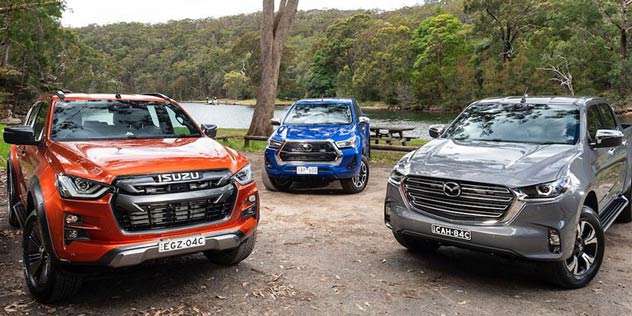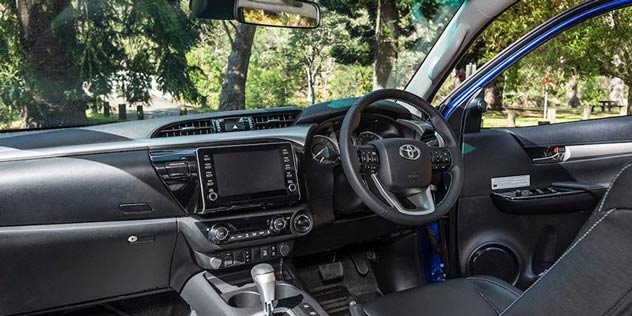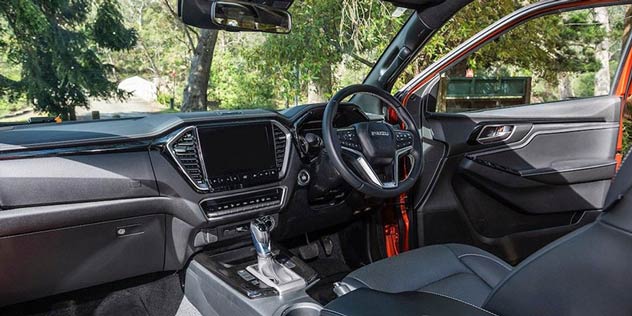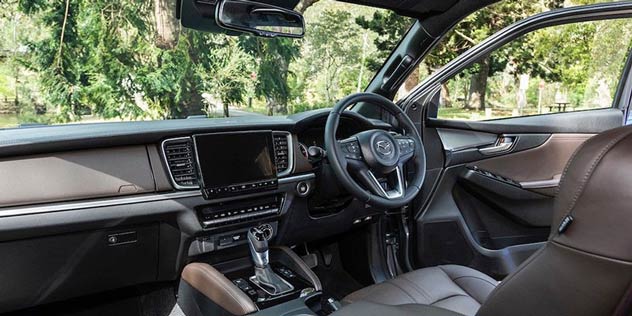
Automotive sales in 2020 have dropped more than 20 per cent compared to 2019. One segment defying the downward spiral, however, is light commercial – no surprise when the Ford Ranger and Toyota HiLux are fighting it out for highest-selling vehicle for the year. With Isuzu and Mazda releasing all-new models and the HiLux undergoing a recent upgrade, there’s no better time to revisit dual-cab utes and see what’s on offer.

If one criticism could be levelled at the eighth-generation HiLux when it launched in 2015, it was around the external design. Many pundits thought that front-on it lacked the tough look and stance of its competitors. In 2018, Toyota launched a trio of new high-spec variants and the latest styling and mechanical revisions for the SR and SR5 built on those themes. With a brief to be more consistent with Toyota’s global ute and truck family, Toyota Australia’s design studio had a hand in the makeover. This resulted in a larger grille with more horizontal detail, while the SR5 gained slimline LED headlamps.
The interior now benefits from a larger eight-inch infotainment screen and, in a nod to its rugged intent and origins, switches replace some of the touchscreen functionality to make changes easier when wearing work gloves. In line with recent Toyota model upgrades, the HiLux’s info setup includes voice activation, Apple CarPlay and compatibility with apps such as Waze, AccuWeather and Stitcher. A redesigned instrument cluster rounds out the interior changes.
The cabin’s changes aren’t immediately obvious until you get under way. The instruments are clearer to read and the switches surrounding the infotainment screen mean it’s easier to make changes on the fly. Driver vision is good, the overall design remains as user-friendly as they come, and all the seats are comfortable. What’s most noticeable around town is the six-speed auto’s sharpness and the improved ride quality unladen, which is now on par with the Ford Ranger (arguably the best in class). While the hydraulic power steering was tweaked to improve low speed assistance, it’s still too heavy for our tastes and where the HiLux falls behind in this comparison.

Toyota engineers have given the 2.8-litre diesels and six-speed auto a serious tune-up, with power boosted to 150kW and torque to 500Nm for automatic versions. Key changes include a larger turbocharger and redesigned fuel injection system, and new cooling and exhaust systems to handle the extra grunt. The six-speed auto has been recalibrated to improve shift quality and the mechanical changes have reduced fuel consumption from a claimed 8.5L/100km to 7.9L/100km.
Engineers revisited the suspension, too, changing the rear leaf spring design and retuning shocks and suspension bushes to improve ride quality. The changes haven’t compromised load carrying, though, with the HiLux’s braked towing capacity now 3500kg. The HiLux safety suite was also upgraded in mid-2019 to include autonomous emergency braking and lane keeping assistance systems. All these improvements have come at a cost, however, with the SR5 auto priced at $59,920.
The revamped engine has a torque curve that delivers 500Nm from 1600rpm. The extra 50Nm makes the HiLux feel punchier and more responsive without the need for a bagful of revs. Toyota’s warranty is five-year/unlimited kilometres and service intervals are every six months with capped price servicing for the first three years at $250 per service.
When we drove the Isuzu D-Max last year it was showing its age in on-road drivability and interior design. D-Max owners are a loyal bunch and were eagerly awaiting the arrival of the new model, which has undergone extensive development and received input from Aussie owners. Pricing starts at $32,200 for a base single-cab chassis and the new hero model tested, the X-Terrain, goes on sale with introductory drive-away pricing of $58,990.
The reputation Isuzu diesels earned for reliability and longevity contributed to the brand’s light commercial popularity in Australia. At the heart of the new D-Max is its 3.0-litre four-cylinder engine re-engineered to produce 140kW and 450Nm, with maximum torque at 1600 to 2600rpm. Isuzu backs the powertrain with a six-year warranty and seven-year capped price servicing that totals $3373 for the period.
The D-Max sits on a longer wheelbase than before and the new external design is visually stronger, highlighted by the large trapezoidal grille. Off-roaders will appreciate the extra wading depth, electronic rear differential lock, and improved approach and departure angles.
As one of the safest utes on the road under 2020 ANCAP test protocols and one of a small handful of vehicles fitted with a centre airbag, the new D-Max also features auto headlights with high beam control.
Inside, the designers have continued the strong trapezoidal theme with two large air vents in polished alloy framing the infotainment screen, below which are controls for the air conditioning and selecting a drive mode. There are plenty of storage options, including a hatch in the top of the dashboard. The leather-trimmed front seats feature more bolstering than their predecessor, lifting seat comfort to the high standard the HiLux sets. Grab rails in the roof pillars for all positions aid entry into the cabin, while the extra wheelbase has improved cabin space in the second row, where the seating position now feels less cramped.

Pressing the engine stop/start button introduces you to a thoroughly more modern D-Max powertrain and the revised engine sounds quieter and more refined. The package is hard to fault, delivering power evenly from low revs and six-speed auto shifts that are more precise.
The improved steering, now electric instead of hydraulic, is immediately noticeable. At low speeds it’s lighter and more direct and connected to the road. The new design also delivers a reduction in turning circle to 12.5 metres. The D-Max feels better through the bends, with less body roll and movement on its springs, and the new-found tautness hasn’t diminished the unladen ride quality, which remains excellent.
Mazda’s previous BT-50 was a collaboration with Ford, part of a relationship formed in the 1980s when Ford repurposed the Mazda Bravo ute to create the Ford Courier. The BT-50’s launch in 2011 coincided with that of the new Ford Ranger, but the Mazda had a different front design and much stiffer suspension compared to its mechanical sibling (in line with Mazda’s ‘Zoom Zoom’ driver focus). Consumers quickly decided they preferred the Ranger and it outsold the BT-50 by a wide margin.
With the decades-long relationship coming to an end, Mazda has partnered with Isuzu for its latest BT-50. Like the D-Max, it has 2WD and 4WD variants, but three spec options (the XT, XTR and GT) rather than four. Initially, body styles will be limited to dual cab and pricing starts at $44,090 for a 2WD dual cab XT, with the 4WD GT auto tested costing $59,990.
The new look certainly polarised the review team, with a few saying the bold grille is too dominant and disconcertingly reminiscent of the Mazda CX-9. Others opined the design flows nicely through to the rest of the body panels and integrates well. Neither camp seemed willing to budge on their stance.
Mazda has injected the GT’s cabin with a touch more class and we prefer it to that in the D-Max. Dark brown leather trim and a soft-touch dash top echo Mazda’s most recent SUV offerings. Controls are essentially in the same position as those in the D-Max, although the dash top storage binnacle is absent and Mazda has opted for more subtle finishes to the air vents and centre console. Seat comfort in all positions mirrors the D-Max and the front seats in the GT are heated.

The 3.0-litre diesel engine (140kW/450Nm) and six-speed automatic are identical to those in the D-Max, as is the claimed fuel consumption of 8.0L/100km. The same goes for its suspension layout (front independent wishbone and rear leaf), electric power steering, 3500kg tow rating and safety package, though at this point there’s no ANCAP safety rating available.
At $3474, the BT-50’s servicing costs are just over $100 higher than Isuzu’s for the same period (and cheaper than the old Ranger-derived BT-50). A five-year/unlimited kilometre warranty is also provided.
All three utes impressed unladen over a range of road conditions, with little discernible difference apart from the HiLux’s heavier hydraulic steering. The trio are all fitted with 265/60X18 Bridgestone Dueller tyres, contributing to their equivalent feel, though the BT-50 did seem quieter in the cabin at cruising speeds.